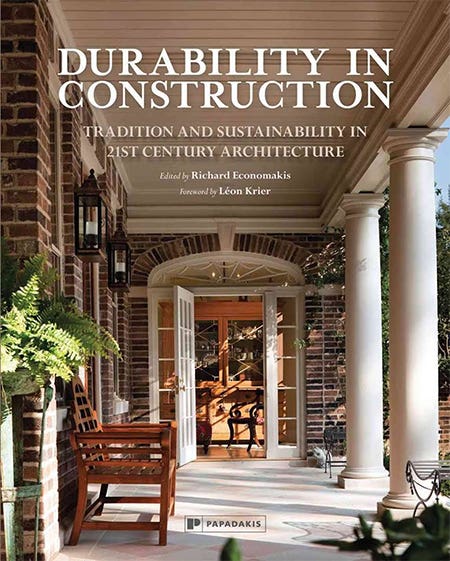
Features
Book Review: Durability in Construction

As an Amazon Associate, we earn from qualifying purchases made through affiliate links.
Durability in Construction: Traditions and Sustainability in 21st Century Architecture
Edited by Richard Economakis; forward by Leon Krier
Papadakis Dist AC; 2015; 224 pages; $50
ISBN-13: 978-1906506551
Reviewed by Alvin Holm
For anyone in doubt about the superiority of traditional architecture over modern this excellent book will set them straight. The modest title, Durability in Construction, hardly hints at the extensive and definitive argument that time-honored methods and materials of construction are not only “greener” in the contemporary sense, but also simply more “durable” in every traditional sense of that word.
This is not a skirmish in the “battle of the styles,” though an aesthetic bias is pretty clear. In the very brief forward, for instance, Leon Krier states that, “The generalized output of throwaway architecture is not only scandalously unsustainable in ecological, but equally in aesthetic, moral, and ultimately in political-economic terms.”
But the general thrust of this compendium of fine essays concerns the evaluation of construction itself, and Krier goes on to say, “The architects featured in this book are not interested in saving mere historic remnants but live languages of construction, and foremost the techniques and the technology that created and sustained those forms, that made them both useful and environmentally desirable for hundreds of generations.” Unlike most other books these days extolling the virtues and beauty of the extensive new work in the classical manner, this volume focuses on construction itself.
This just-published impressive book is based on a colloquium of the same name held in 2010 at the University of Notre Dame Architecture School. It consists of 23 excellent essays by the participants in that event, of varying lengths and on various aspects of the general topic. As far as I know this is a unique endeavor and a formidable contribution to what some of us like to call “The New American Renaissance.”
While this volume so far stands alone, it is gratifying to know that many more are on the way. Richard Economakis, the book’s editor, announces on the frontispiece the following:
“Durability in Construction is the first of what is intended to be a series of publications featuring new built and projected work and focusing on issues and themes that are critical to the thinking of traditional architects, urbanists, academics, and theorists in the 21st Century. This inaugural volume centers on one of the most important of such themes, which has to do with the endurance, re-usability, ecological sensibility, and ultimately the sustainability of new buildings in an age of global exchange.”
In his Introduction Economakis closes by asserting that:
“When we teach the language of classical architecture we do so knowing that in its forms is enshrined the moment of transition from temporality…vulnerable to change and impermanence as it often proves to be, to permanence and an intellectual tradition that can continue to inform future generations of architects and builders.”
As a frequent jury member in his classes at Notre Dame. I can attest to how effective that teaching is. Another eloquent summary of the durability theme is given by Michael Lykoudis, Dean of the Architecture School, in his Preface entitled Durability and the Culture of Building Cities. Ranging from the nuts and bolts of specific building methods through architecture itself, then urban design, and finally to the economy of nations, Lykoudis aptly wraps up “Durability” as an essential promise for tomorrow. He writes:
“Ultimately, durability is a necessary part of a culture of continuity. The classical almost by definition examines the future and the past as a continuum. Classicism is a philosophy that embodies the principle of sustainability. The ever-evolving character of classical and traditional architecture reflects the changes in conventions and the renewal of each generation as the architectural elements of continuity remind us of our debt to the past. The lessons learned from tradition continue to be relevant to resolving tomorrow’s problems.…It is the inventive quality of tradition that allows each generation to shape the future in its own manner, and it is tradition’s projection of the past that provides the sense of stewardship that is required for sustainability and durability.”
The keynote speaker at the Colloquium was the renowned English architect, John Simpson, and it is appropriate that he be given the first position in the extensive series of fine essays. It is perhaps not entirely coincidence that he was recently selected to design the new building for the Architecture School at Notre Dame. Photographs of Simpson’s work in New York City are as enjoyable to look at as his essay is to read. What I learned is substantial, and I thought I knew a lot already.
The importance of this book, I believe, is that all architects, of whatever persuasion, would benefit by reading this collection of excellent essays, as would builders, developers and any others closely involved with contemporary construction. The philosophy and esthetics that accompany most of the writing is valuable but always debatable for better or worse.
The foundation material however, the substance of this work, is clearly factual and demonstrable as well. The nature of materials, the behavior of structures, and the lessons of building history are beyond debate. The presentation of this knowledge, so abundant in this volume, but so little understood in our culture, is the fundamental importance of this timely contribution.
Alvin Holm, AIA, is an early advocate of traditional design, in private practice since 1976, and winner of the first annual Clem Labine Award. He has lectured and taught widely, having initiated a course in Design with the Classical Orders in the National Academy of Design in 1981 and subsequently at many other institutions. He has been an ardent member of ICAA since its inception and prior to that, an officer in Classical America.








